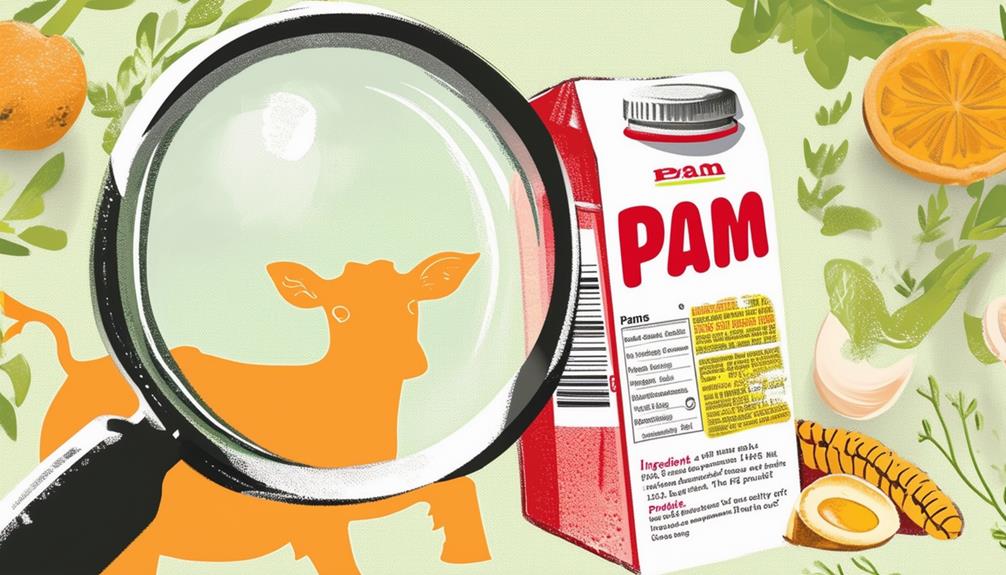You're likely familiar with PAM Cooking Spray, a staple in many kitchens. But have you ever stopped to ponder whether it aligns with a vegan lifestyle? While PAM's canola oil base is plant-based, some ingredients, like glycerin, raise questions about its vegan status. As you examine the label, you might wonder: does PAM's sourcing and processing meet your vegan standards? The answer isn't straightforward, and exploring this question further might just change the way you cook – and think about the food you eat.
PAM's Vegan Status Unclear
While you may think PAM cooking spray is a vegan-friendly option due to its canola oil base, the lack of explicit labeling and unclear sourcing of its ingredients leaves its vegan status uncertain. Although canola oil is a plant-based ingredient, the amount of processing and manufacturing involved in creating PAM's spray raises questions about potential animal-derived additives.
Even a trivial amount of non-vegan ingredients could render the product non-vegan. Without clear labeling, it's difficult to determine whether PAM's oil is sourced from vegan-friendly suppliers or if animal products are used in the manufacturing process.
As a result, some vegans may choose to err on the side of caution and opt for explicitly labeled vegan cooking sprays. However, others may consider PAM's primary composition of plant-derived oils to be sufficient for their dietary needs.
Ultimately, PAM's vegan status depends on individual considerations and preferences, making it crucial to weigh the facts and make an informed decision.
PAM's Spray Contains Glycerin
When you investigate the ingredients in PAM's spray, you'll notice that it contains glycerin, a common additive found in many products. But here's the thing: glycerin can come from plant or animal sources, which raises questions about its vegan status.
Now, let's take a closer look at PAM's flavorful spray options and the role of canola oil as the main ingredient.
PAM's Flavorful Spray Options
As you investigate PAM's flavorful spray options, you'll notice a range of tasty choices that can enhance your cooking. From savory to sweet, these sprays can add a kick of flavor to your dishes.
But what's behind these flavorful sprays, and are they suitable for a vegan lifestyle?
- Buttery Flavor Spray Option
- Baking Spray With Lemon
- Garlic Flavor Spray Option
- Other flavorful alternatives to discover
Buttery Flavor Spray Option
You might assume that PAM's buttery flavor spray options are a convenient and tasty way to add flavor to your cooking, but the presence of glycerin in these sprays raises concerns about their vegan status. Glycerin can be derived from animal fat or plant sources, making it a non-vegan ingredient in some cases.
| Ingredient | Description |
|---|---|
| Coconut oil | Adds a trivial amount of fat, flavor |
| Palm oil | Adds a trivial amount of fat, flavor |
| Glycerin | Derived from animal fat or plant sources |
| Non-stick sprays | Vegan-friendly alternative to buttery flavor sprays |
Baking Spray With Lemon
If you're looking for a vegan-friendly baking spray that adds a burst of citrus flavor to your baked goods, PAM's Baking Spray With Lemon is a great option.
This product information reveals it contains glycerin, a vegan-friendly ingredient often derived from plant-based sources like soybeans or coconut oil.
Dimethyl silicone and oil are also added, but in trivial amounts, making this spray a suitable choice for vegan baking.
Garlic Flavor Spray Option
PAM's Garlic Flavor Spray offers a reliable vegan option for home cooks and professional chefs alike, ensuring a flavorful and convenient cooking experience without compromising on values.
You can enjoy the benefits of PAM's Garlic Flavor Spray, which adds a trivial amount of flavor to your dishes without the concerns of animal-derived ingredients, making it a great vegan choice.
Canola Oil as Main
As you investigate the ingredients of PAM's cooking spray, you'll notice that canola oil takes center stage as the main ingredient.
But what else is in the mix?
Let's take a closer look at the supporting cast of characters that make PAM's spray so effective.
Canola Oil Blend
You'll find that the canola oil blend in PAM's spray is what makes it an effective non-stick cooking solution.
As the main component, canola oil provides a low-fat, calorie-free, and cholesterol-free cooking experience.
The blend also includes glycerin, which adds to its functionality as a versatile cooking aid.
Soy Lecithin Emulsifier Blend
Frequently, soy lecithin emulsifier blends like the one in PAM's spray guarantee that your food releases effortlessly from the cooking surface. This blend, derived from soybeans, prevents sticking and promotes even browning when cooking.
| Ingredient | Function |
|---|---|
| Soy Lecithin | Emulsifier, prevents sticking |
| Glycerin | Smooth texture |
| Canola Oil | Main ingredient, high-heat cooking |
Tocopherol-Rich Vitamin E Oil
Tocopherol-rich vitamin E oil in PAM's spray helps maintain freshness and improves the general cooking experience.
You can feel good about using it, too, since it's vegan-friendly.
This oil is a great complement to the canola oil and glycerin in PAM's spray, making it a suitable choice for those following a vegan diet.
Glycerin's Animal-Derived Origins

When you investigate the ingredients in Pam cooking spray, you'll notice that glycerin is a key component. What you mightn't know is that glycerin can be sourced from animal fat, which raises concerns for vegans.
Now, let's examine the specific points of concern, including honey-derived ingredients and soy lecithin, to better understand their impact on Pam's vegan status.
Honey-Derived Ingredients Present
As you examine the ingredients of Pam cooking spray, you'll notice that it's not just the honey-derived glycerin that raises concerns. You'll also want to ponder other animal-derived ingredients that might be present, such as gelatin, lanolin, or carmine. These ingredients can be hidden in the fine print, but it's crucial to scrutinize the label to make sure it aligns with your vegan lifestyle.
- Gelatin-derived emulsifier present in some products
- Lanolin-derived emollient used in certain formulas
- Carmine-derived red food dye added for color
- Always carefully read labels to confirm products meet your dietary standards
Gelatin-Derived Emulsifier Present
You may not realize that some Pam cooking sprays contain gelatin-derived emulsifiers, which immediately disqualify them as vegan options. These emulsifiers are animal-derived, making them non-vegan.
When shopping for Pam products, it's important to check the labels carefully to make sure that they don't contain gelatin-derived emulsifiers, which can be hidden in the ingredient list.
Lanolin-Derived Emollient Present
Beyond gelatin-derived emulsifiers, PAM cooking sprays also contain other animal-derived ingredients that may surprise you, such as lanolin-derived emollients, which are obtained from sheep's wool.
This means you're indirectly using sheep by-products when cooking with PAM. Furthermore, some PAM products may contain honey-derived ingredients, making them non-vegan-friendly.
Carmine-Derived Red Food Dye
Some PAM cooking sprays contain carmine-derived red food dye, a vibrant colorant extracted from the crushed shells of cochineal insects. This may raise concerns for vegans who avoid animal-derived ingredients.
You'll want to check the ingredients list carefully, as this additive mightn't align with your vegan lifestyle. Be sure to verify before using.
Soy Lecithin Raises Concerns
As you investigate the ingredients in Pam cooking spray, you'll want to take a closer look at soy lecithin, which can be sourced from animal-derived sources like eggs or animal fats, raising concerns for vegans.
You might be wondering if this ingredient aligns with your values, and rightly so. Let's examine some other points of interest, including genetically modified organisms, high-fructose corn syrup, refined sugar content, and sodium caseinate milk derivative.
- Genetically Modified Organism (GMO) concerns in Pam ingredients
- High-Fructose Corn Syrup's impact on veganism
- Refined Sugar Content and its potential animal-derived origins
- Sodium Caseinate Milk Derivative: is it vegan-friendly?
Genetically Modified Organism
When you scan the ingredient list on a can of Pam cooking spray, you mightn't ponder twice about soy lecithin, but this common additive can be derived from genetically modified soybeans, sparking concerns about the environmental impact and health risks associated with GMOs.
As a consumer, you may wish to contemplate the potential risks and choose a cooking spray with non-GMO ingredients that align with your values.
High-Fructose Corn Syrup
What role does high-fructose corn syrup play in the ingredients of Pam cooking spray?
As a common ingredient in many processed foods, high-fructose corn syrup is plant-based, making it suitable for vegans.
Should you be concerned about its presence in your cooking routine?
You can rest easy knowing this ingredient won't compromise your vegan lifestyle.
Refined Sugar Content
You're likely wondering about the refined sugar content in Pam cooking spray, and whether it's a concern for your vegan lifestyle. Rest assured, the refined sugar in Pam is derived from plant sources, making it vegan-friendly. Here's a breakdown of the ingredients:
| Ingredient | Source | Vegan Status |
|---|---|---|
| Refined Sugar | Plant-based | Vegan |
| Glycerin | Potential animal-derived | Check with manufacturer |
| Soy Lecithin | Plant-based, may be GMO | Generally considered vegan |
| High-Fructose Corn Syrup | Plant-based | Vegan |
| Other Ingredients | Varies | Check labels for vegan status |
Sodium Caseinate Milk Derivative
Pam cooking spray's ingredient list reveals a surprising culprit: sodium caseinate, a milk derivative that immediately raises red flags for vegans.
You're probably thinking, 'Wait, isn't Pam vegan?' Not quite. Sodium caseinate is a non-vegan ingredient that can be a deal-breaker for those following a plant-based diet.
Its presence in Pam spray makes it unsuitable for vegans.
Vegan-Friendly Alternatives Exist
Fortunately, vegan-friendly alternatives exist, allowing you to cook with confidence and convenience while staying true to your plant-based lifestyle.
As a vegan, you don't have to guarantee on flavor or convenience when cooking. PAM cooking spray offers a reliable vegan-friendly option for your non-stick cooking needs. The ingredients, such as canola oil, coconut oil, and soy lecithin, are plant-based and suitable for vegan diets. You can rest assured that PAM doesn't contain any animal-derived ingredients, making it a great alternative to traditional cooking sprays.
By choosing PAM, you can be certain that your cooking remains cruelty-free and plant-based. This convenient cooking spray provides flexibility in different recipes, allowing you to cook with ease and confidence. With PAM, you can focus on creating delicious meals that align with your vegan principles.
Conclusion
So, is PAM vegan?
The answer isn't a simple yes or no. While its canola oil base is plant-based, the presence of glycerin and other potential non-vegan additives raises concerns. If you're a vegan, it's crucial to weigh the ingredients and processing methods against your personal standards.
Luckily, there are vegan-friendly cooking spray alternatives available, offering a clear conscience and a clear kitchen.
